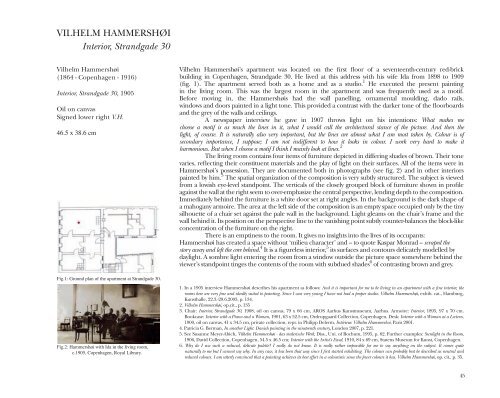Catalogue 2010 - daxer & marschall
Catalogue 2010 - daxer & marschall
Catalogue 2010 - daxer & marschall
You also want an ePaper? Increase the reach of your titles
YUMPU automatically turns print PDFs into web optimized ePapers that Google loves.
VILHELM HAMMERSHøI<br />
Interior, Strandgade 30<br />
Vilhelm Hammershøi<br />
(1864 - Copenhagen - 1916)<br />
Interior, Strandgade 30, 1905<br />
Oil on canvas<br />
Signed lower right V.H.<br />
46.5 x 38.6 cm<br />
Fig.1: Ground plan of the apartment at Strandgade 30.<br />
Fig.2: Hammershøi with Ida in the living room,<br />
c.1905, Copenhagen, Royal Library.<br />
Vilhelm Hammershøi’s apartment was located on the first floor of a seventeenth-century red-brick<br />
building in Copenhagen, Strandgade 30. He lived at this address with his wife Ida from 1898 to 1909<br />
(fig. 1). The apartment served both as a home and as a studio. 1 He executed the present painting<br />
in the living room. This was the largest room in the apartment and was frequently used as a motif.<br />
Before moving in, the Hammershøis had the wall panelling, ornamental moulding, dado rails,<br />
windows and doors painted in a light tone. This provided a contrast with the darker tone of the floorboards<br />
and the grey of the walls and ceilings.<br />
A newspaper interview he gave in 1907 throws light on his intentions: What makes me<br />
choose a motif is as much the lines in it, what I would call the architectural stance of the picture. And then the<br />
light, of course. It is naturally also very important, but the lines are almost what I am most taken by. Colour is of<br />
secondary importance, I suppose; I am not indifferent to how it looks in colour. I work very hard to make it<br />
harmonious. But when I choose a motif I think I mainly look at lines. 2<br />
The living room contains four items of furniture depicted in differing shades of brown. Their tone<br />
varies, reflecting their constituent materials and the play of light on their surfaces. All of the items were in<br />
Hammershøi’s possession. They are documented both in photographs (see fig. 2) and in other interiors<br />
painted by him. 3 The spatial organization of the composition is very subtly structured. The subject is viewed<br />
from a lowish eye-level standpoint. The verticals of the closely grouped block of furniture shown in profile<br />
against the wall at the right seem to over-emphasize the central perspective, lending depth to the composition.<br />
Immediately behind the furniture is a white door set at right angles. In the background is the dark shape of<br />
a mahogany armoire. The area at the left side of the composition is an empty space occupied only by the tiny<br />
silhouette of a chair set against the pale wall in the background. Light gleams on the chair’s frame and the<br />
wall behind it. Its position on the perspective line to the vanishing point subtly counter-balances the block-like<br />
concentration of the furniture on the right.<br />
There is an emptiness to the room. It gives no insights into the lives of its occupants:<br />
Hammershøi has created a space without ‘milieu character’ and – to quote Kaspar Monrad – scraped the<br />
story away and left the core behind. 4 It is a figureless interior, 5 its surfaces and contours delicately modelled by<br />
daylight. A sombre light entering the room from a window outside the picture space somewhere behind the<br />
viewer’s standpoint tinges the contents of the room with subdued shades 6 of contrasting brown and grey.<br />
1. In a 1905 interview Hammershøi describes his apartment as follows: And it is important for me to be living in an apartment with a fine interior, the<br />
rooms here are very fine and ideally suited to painting. Since I was very young I have not had a proper studio. Vilhelm Hammershøi, exhib. cat., Hamburg,<br />
Kunsthalle, 22.3.-29.6.2003, p. 134.<br />
2. Vilhelm Hammershøi, op.cit., p. 135<br />
3. Chair: Interior, Strandgade 30, 1908, oil on canvas, 79 x 66 cm, AROS Aarhus Kunstmuseum, Aarhus. Armoire: Interior, 1895, 97 x 70 cm.<br />
Bookcase: Interior with a Piano and a Woman, 1901, 63 x 52.5 cm, Ordrupgaard Collection, Copenhagen. Desk: Interior with a Woman at a Lectern,<br />
1900, oil on canvas, 41 x 34.5 cm, private collection, repr. in Philipp Delerm, Intérieur. Vilhelm Hammershoi, Paris 2001.<br />
4. Patricia G. Berman, In another Light. Danish painting in the nineteenth century, London 2007, p. 221.<br />
5. See Susanne Meyer-Abich, Vilhelm Hammershøi - das malerische Werk, Diss., uni. of Bochum, 1995, p. 62. Further examples: Sunlight in the Room,<br />
1906, David Collection, Copenhagen, 54.5 x 46.5 cm; Interior with the Artist’s Easel, 1910, 84 x 69 cm, Statens Museum for Kunst, Copenhagen.<br />
6. Why do I use such a reduced, delicate palette? I really do not know. It is really rather impossible for me to say anything on the subject. It comes quite<br />
naturally to me but I cannot say why. In any case, it has been that way since I first started exhibiting. The colours can probably best be described as neutral and<br />
reduced colours. I am utterly convinced that a painting achieves its best effect in a colouristic sense the fewer colours it has. Vilhelm Hammershøi, op. cit., p. 35.<br />
45






